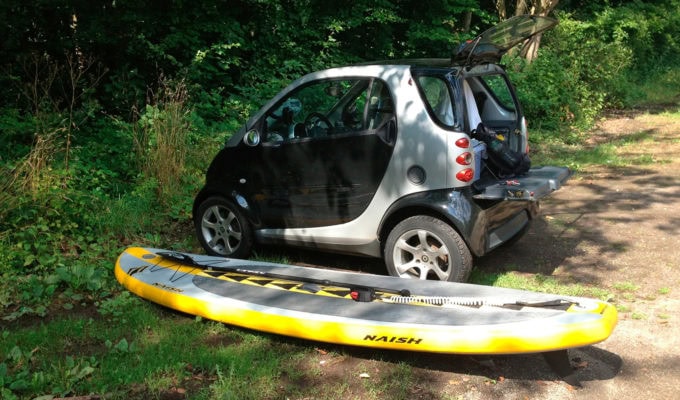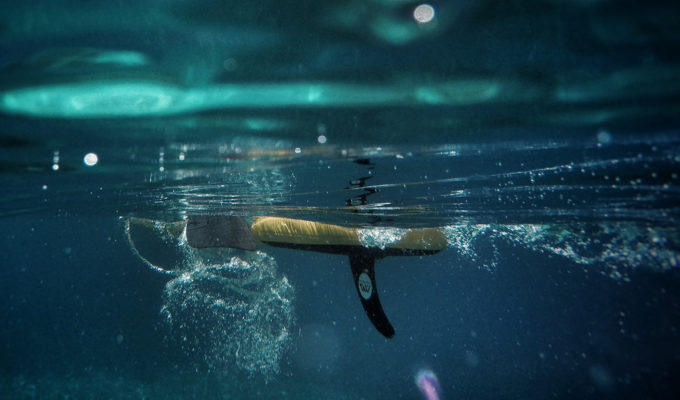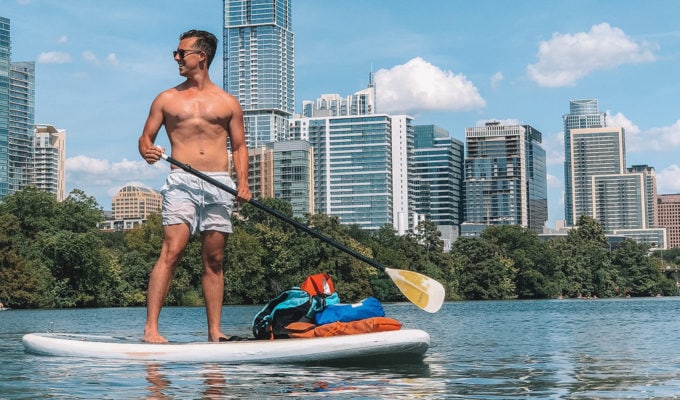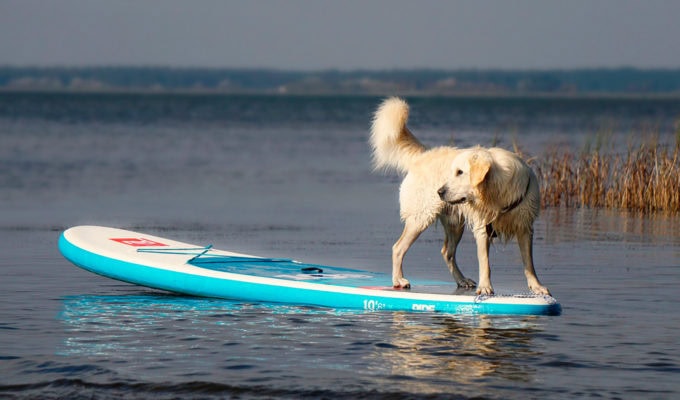Why Buy An Inflatable Paddle Board?
Stand up paddle boarding is a great way to get out onto the water without needing to have a lot of specialized gear or experience.
Inflatable paddle boards are changing the game because they are not only surprisingly rigid like an epoxy (hard) board and easy to use; they also fold down to a much smaller size.
Once folded down and placed in a bag they can go pretty much anywhere with you. They fit in cars, can be carried on your back, and I even transport mine around with my bicycle.
See Also: 10 Things To Know Before Buying An Inflatable Paddle Board
So what are you losing when you buy an ISUP (Inflatable Stand Up Paddleboard) instead of a solid SUP (Stand Up Paddleboard)? The answer is not a lot.
Solid SUP’s have no give and can be a little more stable than inflatables but not by much.
The increased stability can be useful if you are tall and have a hard time balancing, or if you are planning on packing a lot of gear for camping or long tours.
They don’t have as much drag, so you get a little more distance from every paddle.
See Also: Best Inflatable Paddle Boards (ISUP) For Dogs
Having said this, ISUP’s have come a long way over the years, I have tried out a lot of boards, and I’ve found that there are inflatables out there that feel just as stable as solid boards and can be very fast on the water.
If you’re interested in more differences between inflatable and solid paddle boards, check out my post about it.

When I first heard about inflatable paddle boards, my first concern was how can they possibly be durable enough to last as long as a solid board. After trying out a friend’s ISUP one day at the lake, I soon discovered that they are very sturdy.
The primary material used is PVC, which is a widely used type of plastic that is versatile, lightweight, and long-lasting. Whenever I use a solid board, I have to be extra careful of things like rocks or sunken logs in the water, so I don’t ding or scratch it.
ISUP’s bounce right off obstacles, and they are hard to scratch as well. Although I don’t recommend it, you can drag them around and throw them off of your car, and they’ll still be good as new.
They’re not easy to puncture either, and if you do spring a leak, they are simple to patch with a spare piece of PVC and some glue.
How To Choose The Right Paddle Board For You
Once you’ve decided on buying an ISUP, there are a few things to consider when choosing the right style for you.
The biggest thing to think about is what kinds of activities you want to do. If you’re like me, you can buy a standard “all-around” ISUP for paddling around, jumping off to swim, and floating around, but there are so many more things you can do.
Yoga, fishing, touring, racing, surfing, river surfing in whitewater, and whatever else you can think of. I’m going to outline some of the basic paddle board designs and what they do, to help you decided what is right for you.
See Also: Best Multi-Person Inflatable Paddle Board (Giant ISUP)
Hull Style
The hull is the front portion or nose of a paddle board. There are two basic shapes, pointed or rounded.
The pointed style is called a displacement hull because it cuts through the water, displacing it to the side. It’s much like what you would see on a canoe or kayak.
The design helps keep the paddle board moving straight. It’s good for things like touring, racing, and fitness paddling because it makes it easier to go long distances and stay straight when paddling fast.
Because the nose is narrow, it makes it a little less stable and more difficult to turn. It’s still an ok design for beginners but if you have a hard time balancing it might make it a little more challenging to stand up.
The second kind is called a planing hull. It has a wide round nose that is slightly curved to raise it out of the water. This type of hull is the most common on the “all-around” inflatable paddle boards.
It’s very popular with all skill levels because the planing hull is so versatile. It bounces off of obstacles easily making it great for river paddle boarding, and it jumps on top of waves for surfing.
See Also: Best Inflatable Paddle Boards (ISUP) for Beginners
The wideness of it makes it more stable than a displacement hull, so things like yoga and fishing are much easier. It’s also more maneuverable when turning. Just because it’s not specialized for paddling fast doesn’t mean you can’t. I’ve raced people with displacement hulls with my planing hull and won.
There is a sort of hybrid hull that is starting to become popular. It’s basically a wide nose with a slight point. It takes the best of both styles and combines them.
I think it’s a cool idea especially for beginners who aren’t sure what they like to do yet. From my experience, they perform more like planing hulls because they still have the raised nose, but they do paddle a little straighter.

Fins
The most common fin styles are a single removable fin, a 2+1 system where there are a long removable center fin and 2 smaller non-removable (side bite) fins on each side, or 3 removable fins.
Each kind plays different roles but usually more fins mean paddling straight will be easier and fewer fins means easier turning and maneuvering.
The single removable fin set up is very common on all-around boards. It is usually slid into a fin box and then secured with either a bolt or a clip. It has the least amount of drag as the other setups and works well on flat water like lakes.
The 2+1 set up was intended initially for surfing because most of the steering is done from your back foot and “side bite” fins are needed to keep the board moving straight.
I’ve noticed that a lot of the newer boards coming out have side bites. It’s a good idea to help beginners learn to paddle, and I like the idea of using more fins to complete the idea of an “all-around” board. If you have a 2+1 setup, then you will not only be able to use your board on flat water you could also take it to the ocean or a river and have a more enjoyable time.
See Also: 5 Tips For Storing Your Paddle Board (ISUP) Or Kayak Inflated
The 3 fin set up is different from the 2+1 because the two side fins are removable and much longer. They are called “thrusters.”
The main thing the thrusters do is keep the board straight so you can paddle more on one side before you have to switch. They also really help in waters with a lot of surf because they keep the water from pushing around the board, on that same note they help in the wind as well and on extra-large multi-person ISUPs.
Board Length, Width, and Thickness
The length, width, and thickness of your inflatable paddle board can be important because not only does it help specialize in different activities it also adds or subtracts from the weight capacity.
If you are a bigger person you may need a bigger board, or if you are a smaller person planning on bringing a lot of gear you want a longer board that is not too wide to paddle comfortably.
When talking about length, there is a guide you can follow most of the time. If it’s under 10 feet it’s for surfing or kids, if it’s 10-12 feet it’s all-around and good for things like yoga or fishing.
A board that is 12-14 feet is going to be for racing, fitness paddling, or long tours because it can fit a lot of gear. Anything longer than that is going to be a tandem or multi-person.
See Also: Are You Paddle Boarding Legally Under USCG Regulations?
The width is important because the wider it is, the more stability it will have. You don’t want to take it too far and buy the widest board you can find, it should match your size. When a board gets too wide, it can be harder to paddle correctly and become difficult to manage.
Another thing about width is that it can be specific to an activity. Narrowness creates less drag and makes a paddle board move faster in the water. A narrow ISUP is mostly for racing, fitness paddling, and long tours.
More width is more stable, and a wider board is excellent for bringing your dog along, fishing, and SUP yoga. If you want something in between that is for all-around use, then a suitable width is anywhere from 29-32 inches.
Thickness is critical when it comes to inflatable paddle boards. The main downside to an inflatable board is they have more give than a solid SUP, and this makes them less stable.
Because of this, they have to be thicker to be stiff enough. ISUPs can be 4-8 inches thick. A 4-inch board is excellent for surfing and children, 8 inches is usually for mega paddle boards. A great all-around board is 5-6 inches thick.

Storage and Weight Limit
The reason I’m putting these two together is they go hand in hand. Weight limit usually isn’t an issue if you’re not worried about bringing stuff. The average all-around ISUP has a weight limit of around 275 lbs and has a bungee system on the nose for holding down a life vest or a dry bag.
For me, storage is a big deal because I like to load on a cooler, a life vest, a dry bag, a speaker, and sometimes even a small chair, and that’s when I’m going out for the day.
If I’m going on an overnight tour then I usually have a tent, and sleeping gear as well. Because of this, I look at D-link placement and weight limit carefully when I buy.
See Also: Best Slim Inflatable Life Jackets (PFD)
D-links are a great way to tie down your gear and create more storage without having to give up deck space when you aren’t bringing stuff. Touring boards usually have a lot of D-links and multiple bungee storage systems.
While all-around boards pretty much always have a bungee system on the nose and sometimes have D-links that go along the sides for securing kayak seats or coolers.
You can buy D-links (click to view on Amazon) that are attached to a piece of PVC and glue (click to view on Amazon) them on yourself if you prefer something more custom.
Board Weight
The weight of the board itself may not seem all that important, but you’re probably considering an ISUP because it is portable and easy to store.
I didn’t think much about how much my first board weighed until I decided to take it with me on a hike to a mountain lake.
See Also: Best Lightweight Paddle Board (ISUP) for Hiking, Travel
I soon found that although it came with a bag that was also a backpack, it was really heavy. An all-around 11-foot board can weigh anywhere from 20-30 lbs depending on how it was built.
It’s good to keep this in mind if your main paddle boarding spot requires a lot of walking to get to or if you are planning on hiking with it.
PVC Layers
Every company has its way of building and engineering an ISUP. There are different gluing techniques, grades of PVC, and most important different numbers of layers of PVC.
Usually, the higher you go with the price of an ISUP the more layers of PVC it has. I’ve seen single-layered boards with double-layered seams, and even quad layered PVC. The nice thing about more layers is that it increases durability and makes the board stiffer at a lower psi.
The only downside to more layers is increased board weight, which can be a bummer if you have a long way to walk.
See Also: Best Life Jackets (PFD) For Dogs
My first ISUP was a budget board with a single layer of PVC, and I think it’s great. It’s held up well over the years, and I’ve never regretted purchasing it. That being said, it’s only ever been on flat water, and I haven’t run into anything sharp.
Depending on the situation in the water you will be floating on you may want more layers. Also if you are planning on bringing a dog with you, more layers are better to help protect from their claws and the occasional jump.
For more information on paddle boarding with a dog check out this article here.

Where Do I Start?
It can be overwhelming reading about paddleboards and all the different things they can do. If you still aren’t sure what to buy you can always rent a few different styles first and see what you enjoy doing the most.
Make sure you purchase something you will like, if it doesn’t fit the guidelines exactly, that’s ok. Even if it’s for a specific type of activity, it doesn’t mean it won’t work for something else.
Paddleboarding is a fun, rewarding activity that is not only good exercise, but it’s something everyone can do and enjoy.
Check out our post about the best boards for beginners.
Have any questions about inflatable paddle boards? Leave a comment below.
